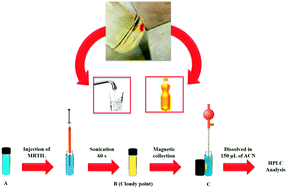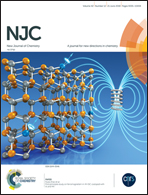Dispersive liquid–liquid microextraction using magnetic room temperature ionic liquid for extraction of ultra-trace amounts of parabens†
Abstract
In this work, a dispersive liquid–liquid microextraction (DLLME) method using methyltrioctylammonium tetrachloroferrate was employed for the extraction of ultratrace amounts of parabens in water, beer and beverage samples. The method was followed by HPLC-UV for separation and determination of the parabens. The ability to magnetically manipulate the ionic liquid combines the general properties of ionic liquids with those associated with the incorporation of a metal ion in their structure, such as a strong response to an external magnetic field. This property is much exploited in the field of extraction due to elimination of the centrifugation step, decreasing the analysis time and providing more simplicity. The effective parameters for the extraction of parabens were investigated and optimized by the one-variable-at-a-time method. Under the optimized conditions (acetone as the disperser solvent; disperser solvent volume of 250 μL; sonication time of 1.0 min; sample pH of 6.0, and salt concentration of 25% w/v), the limits of detection and quantification were found to be within the range of 0.3–0.5 and 1.0–1.5 μg L−1, respectively. Calibration graphs showed good linearity with coefficients of determination higher than 0.9977 and relative standard deviations lower than 10.4%. In addition, the relative recoveries for the spiked samples were within the range of 95–103%, indicating good accuracies as well as the absence of matrix effects. The results obtained in this work suggest that magnetic ionic liquids can be a promising solvent for future applications of DLLME and the related sample preparation techniques.



 Please wait while we load your content...
Please wait while we load your content...